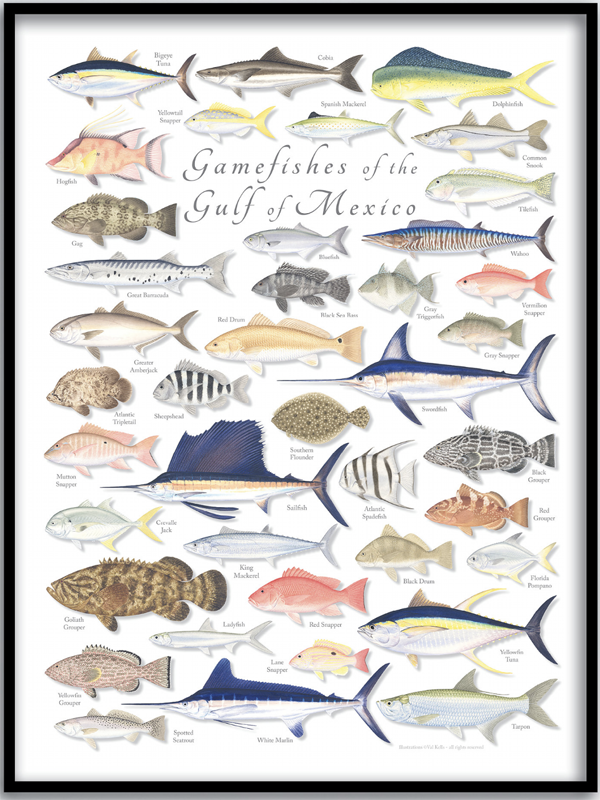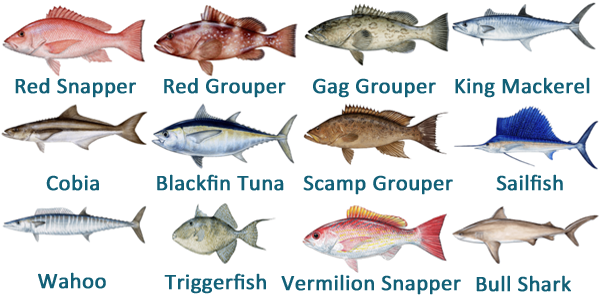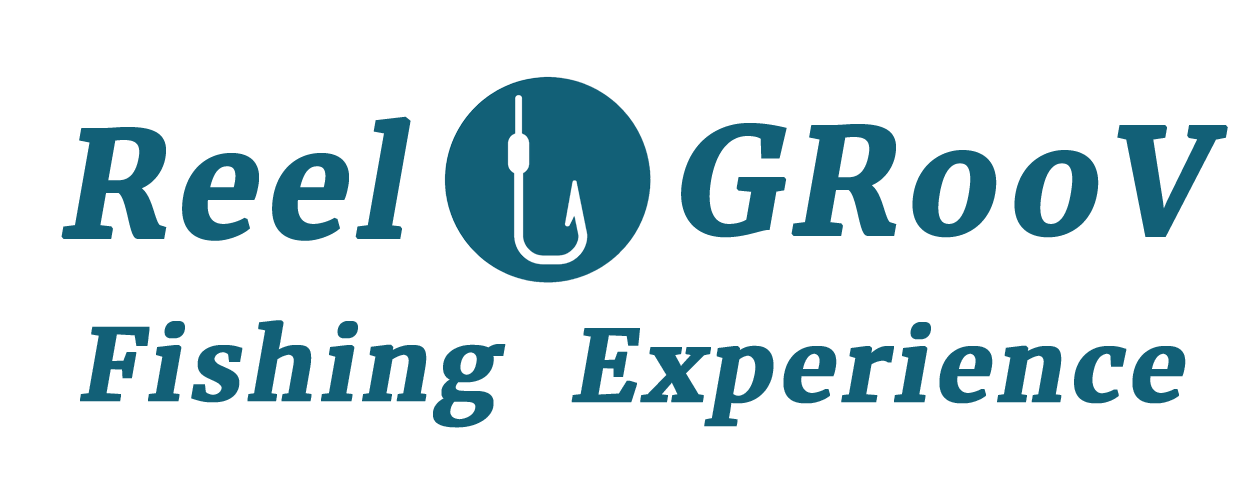
Gamefishes of the Gulf of Mexico

Fish Species We Target in the Gulf of Mexico

Additional fish species we might also encounter include:
Amberjack, Spanish Mackerel, Black Grouper, Snowy Grouper, Lane Snapper, Mangrove Snapper, Mutton Snapper, Cubera Snapper, Yellowtail Snapper, Redfish, Yellowfin Tuna, Bluefin Tuna, Bonita, Dusky Shark, Snook, Spadefish, Nurse Shark, Sand Shark, Blacktip Shark, Mako Shark, Hammerhead Shark, Thresher Shark, Tiger Shark, Hogfish, Black Drum, Flounder, Dolphin (Mahi Mahi), Almaco (Jack), Jack Crevalle, African Pompano, Lionfish, Ladyfish, Perch, Pompano, Rainbow Runner, Rockfish, Porgy, Seabass, Sheepshead, Speckled Trout, Squid, Tarpon, Tilefish, Tripletail
The Different Types of Fishing
Deep Sea Fishing - This type of fishing usually requires a charter boat capable of traveling far enough from shore to reach a water depth of at least 30 meters or 90-100 feet. In the case of Panama City, FL going this far off shore also includes a special Federal License. Most people prefer deep sea fishing for the large variety of fish found at those depths such as marlin or sailfish.
Bottom Fishing - The primary benefits of bottom fishing is the quantity of fish in a single haul. Areas with underwater structures such as large shipwrecks or natural reefs provide shelter, food, and breeding grounds for many different species of fish and contribute to its larger numbers. Amberjack, grunts, sea bass, triggerfish, and even sheepshead can be found in these habitats and your patients will pay off with a large number of fish in your basket.
Trolling - In Panama City, FL to get to the best deep sea fishing grounds you need to travel 10 to 40 miles offshore. High-speed trolling during those long trips allows for some additional fishing time. This generally makes for an exciting day on the water with the possibility of catching larger fish such as Amberjack, King Mackerel, Spanish Mackerel, Mahi Mahi, Sailfish, Tuna, or big Wahoo.
Inshore Fishing - This type of fishing can mean everything from beach fishing, fishing from a pier, or even a small boat in the bay or inland waters. It includes anything within 9 miles of the shoreline, or always insight of land, and less than 30 meters or 90 feet deep. Snapper, snook, striped bass, tarpon, and trout are some of the more common fish species found in these waters.
Reef and Wreck Fishing – Reefs are made of naturally occurring materials such as rocks or the skeletons of small animals called corals. Reefs can also be artificial or man-made structures and can include everything from shipwrecks, planes, cars, tires, or anything created by human beings. These sites offer protection for many different species of fish and other marine life and depending on the size of the reef can be a resource for catching large numbers of fish.
The Different Techniques of Fishing
Heavy tackle often refers to the heftiest gear in an angler's tackle box, but this doesn't always include giant rods and reels. As a relative term, “heavy tackle” for one species could be considered “light tackle” for another.
Light tackle anglers tend to use small sharp hooks that are far less injurious to a fish than a heavy tackle angler's large hook. They tend to be sterile (fresh from the packet), of high-quality steel, and laser-sharp. They are used by fishers who are expert at not gut-hooking fish (a big no-no with any tackle).
Spin fishing is an angling technique where a spinnerbait, a type of hybrid fishing lure with at least one freely rotating blade, is used to entice the fish to bite.
Jigging is one of the most active fishing methods, requiring you to snap or pop the rod tip up quickly to move the lure vertically in the water column. When learning how to jig, you can try either jigging straight up and down as you drift, or casting the lure out and jig it back towards you horizontally while reeling.
Pop fishing or "popping is one of the most exciting ways to fish as you can witness all the action close to the surface of the water. This style of fishing involves dragging a lure known as a popper across the surface of the water with a short sharp retrieving action.
Drift fishing allows you to fish over a variety of habitats as your boat drifts with the currents or wind movement. You can drift on the bottom or change the depth with a bobber or float. Natural baits work best.
Kites are an indispensable part of today's offshore arsenal. Originally used by islanders to set their baits away from shore, kites are now used much in the same way and keep baits away from the boat and up near the surface where they attract more attention.
Booking Is Easy
We offer fishing tours running for 4, 6, 8, 10, or 12 hours. We also book sunset, catered dinner, and beverage cruises.
Go to our unique booking page and book your next private charter, dolphin or sightseeing cruise with Reel GRooV Charters.
Schedule Your Next Trip
Current Weather in Panama City Beach, FL
Policies
Book online or over the phone with a $500 deposit & pay the balance the day of your trip OR pay the full balance when booking.
When the captain confirms your trip, you will be charged a $500.00 deposit to guarantee your reservation. The remaining balance is to be paid directly to the charter operator on or prior to your trip date in one of the following payment methods:
Payment
Cash All Major Credit Cards Debit PayPal
When paying the remaining balance with a debit or credit card, an additional 4% charge will apply.
Meeting Location
Treasure Island Marina, 5550 N Lagoon Drive, Panama City Beach, FL 32408. Please arrive 15 minutes before your scheduled trip. If the boat isn’t in the slip when you arrive, we may be getting fuel or returning from our previous trip. We will be with you ASAP.
Change or Cancellation policy
After booking, you may cancel within 24 hours for a full refund. After 24 hours, your deposit is non-refundable.
If you choose to pay the full amount, you can cancel with a refund (- deposit) up to 30 days before your trip date.
If you need to change the number of guests in your group, we will settle up the difference the day of the trip.
In the case of unsafe weather conditions or a boat malfunction, we will try our best to reschedule your trip to another available date/time. If we are unable to reschedule, we will refund the full amount to you.
